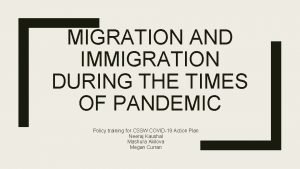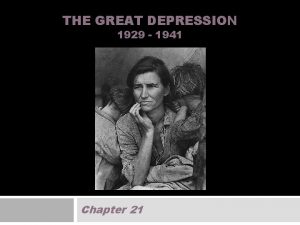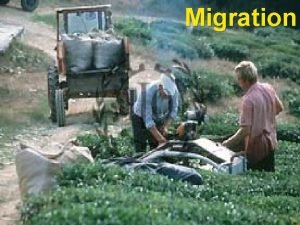The Great Migration http www inmotionaame orgmigrationslanding cfm














- Slides: 14

: The Great Migration http: //www. inmotionaame. org/migrations/landing. cfm? migration=8

LEAVING THE SOUTH Several factors precipitated one of the largest population shifts in the country's history. In 1898 the tiny boll weevil invaded Texas and proceeded to eat its way east across the South. Crops were devastated, thousands of agricultural workers thrown off the land, and the long reign of King Cotton as the region's economic backbone was finally brought to an end.

Even more important was World War I. Its onset in Europe, in 1914, brought a halt - within three years - to the massive immigration of European industrial workers which had been going on for some sixty years. By 1900 more than a million were settling in the United States each year.

Although the country did not enter the conflict until 1917, it had been supplying the European combatants since hostilities began. The cessation of immigration resulted in an acute labor shortage at a time when workers were needed to gear up the arms and war-supplies industries. The war created an economic boom, and an alternative supply of labor was needed to meet the increased demand. The South, with its surplus of workers resulting from agricultural disaster and chronic underdevelopment, clearly fit the bill.

The region in 1916 suffered not only from underdevelopment, but also from isolation. Its separation from mainstream America was the result of unique historical factors: the institution of slavery, its slow recovery from the devastating Civil War, and its overreliance on cotton as the region's economic engine.

The South was behind the rest of the country at the start of Reconstruction, and its disadvantage only grew over time. It had fewer schools, lower literacy levels, and poorer basic services

The rural areas had slow and inadequate communication with the outside world. In comparison to their counterparts in the Northeast and Midwest, southern workers were grossly underpaid; their wages no more than two-thirds of those paid elsewhere in the country

Indeed, the region was more of a colony exporting raw materials than an equal trading partner to the more economically advanced North. Large numbers of skilled workers, white and black, were trapped.

In addition, the political and social climate was deteriorating. Between 1890 and 1910, most African Americans in the South had lost the right to vote through restrictive requirements such as property qualifications, poll taxes, literacy tests, and the "grandfather clause" that limited the vote to those whose grandfathers were registered voters, thus disqualifying blacks who had gotten the franchise only with the Fifteenth Amendment in 1870.

The tightening of Jim Crow laws led many to leave the South, as illustrated in Alabamian Charles "Cow Cow" Davenport's Jim Crow Blues:

Intimidation and outright violence were also used not only to disenfranchise the black community, but also to control and terrorize it. At least two to three people were lynched every week

Although lynching had been used for decades, it evolved in the late nineteenth and early twentieth centuries, becoming more sadistic and exhibitionist. People were horribly tortured and mutilated for hours in front of huge crowds that included women and children.

Though economic, social, environmental, and political forces were crucial to the migration, so too was the indomitable will of the African-American migrants, their burning desire to control their own destinies.

The decision to pull up one's long planted roots and journey into the unknown is not easily made. For southern migrants, it was a balancing act. Serious questions had to be answered: How bad is it here? How good is it there? Who in the family will make the journey? How will those left behind be cared for? How much will it cost? Where will I live?
 Sindrome de turner
Sindrome de turner Q=va
Q=va Https eweb sba gov gls dsp_login cfm
Https eweb sba gov gls dsp_login cfm Cfm wfp
Cfm wfp Rraduct
Rraduct Dr paige berryman
Dr paige berryman Ethernet lmi ce
Ethernet lmi ce Cfm cash recycler
Cfm cash recycler Http://metrocosm.com/global-migration-map.html
Http://metrocosm.com/global-migration-map.html Looking backward political cartoon explanation
Looking backward political cartoon explanation Second great migration
Second great migration Second great migration
Second great migration Siat.ung.ac.id krs
Siat.ung.ac.id krs Http //mbs.meb.gov.tr/ http //www.alantercihleri.com
Http //mbs.meb.gov.tr/ http //www.alantercihleri.com Http://www.history.com/topics/great-depression
Http://www.history.com/topics/great-depression



























